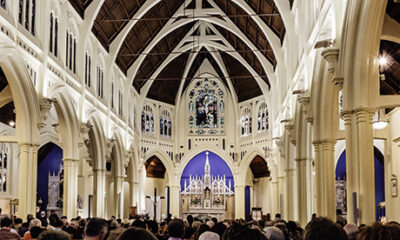Recently Britney Spears made a stir in Catholic circles when she told her Instagram followers that she had wanted to get married in a Catholic church in Los Angeles but had been turned away.
Britney Spears, who has since had her wedding to longtime boyfriend Sam Asghari in the backyard of her Beverly Hills mansion, didn’t mention what church it was. But reporters figured it out and asked for a statement from St. Monica’s Catholic Church, a vibrant parish community in Los Angeles.
The parish said they had no knowledge of Spears ever requesting to get married there.
In a follow-up post, Britney Spears explained that she had asked her wedding planner if she could marry Asghari at St Monica’s.
She said, in fact, it was “the first request” she had put to the planner upon agreeing to work with them.
Six weeks later, she had been told no by the planner and assumed the parish had rejected her request.
Now, some Catholics might see Britney Spears as oblivious or uninterested in what exactly it means to get married in a Catholic church. “It’s not just a random venue,” one of her followers responded to the original post (which has since been taken down).
But Spears’ attraction to St Monica’s was pretty clearly not just about getting a great spot for the ‘grams.
In her original post, she wrote about her desire to go to St Monica’s during the pandemic: “I wanted to go every Sunday,” she wrote. “…It’s beautiful and they said it was temporarily shut down due to COVID!!!! Then 2 years later when I wanted to get married there they said I had to be Catholic and go through TEST !!!!”
In her second post, she repeated that she has had a long-standing desire to go to St Monica’s.
“During the 2 years of Covid, I also wanted to go there … I was told no due to the pandemic …”
There are three
key phases
the evangeliser
needs to speak to.
These aren’t the only times Spears has written in a positive way about Catholicism, either.
In August 2021, she posted about attending a Mass: “I just got back from Mass…I’m Catholic now…let us pray!” Catholic commentator Austin Ivereigh kidded on Twitter, “Next on Catholic news: Britney Spears names her puppy #Traditionis Custodes.”
Pundits seemed to spend a lot of energy debating whether or not she had officially converted, but to my mind, they missed the point entirely. She had been to Mass and was happy enough about the experience to mention it and kid around a bit.
In the case of Spears’ wedding, it seems that the parish had nothing to do with what happened. And if you’re ever visiting Los Angeles, I highly recommend St Monica’s. Britney Spears is right. It’s a great place.
Situations similar to hers come up pretty often in many of our parishes. Especially when it comes to weddings and funerals, there are times when people come to our churches wanting things that don’t necessarily fit our categories.
- They want a pop song at a funeral.
- They want a non-religious ritual included in their wedding.
- Or they want to get married here, even though they aren’t Catholic.
It can be very easy to get hung up on the specific problems of their requests, not only because some of the same issues come up again and again (raise your hand if you’ve had someone insist they need “Stairway to Heaven” at a funeral), but because many of our parishes are already overwhelmed with the normal demands of their regular parishioners.
When you’ve got only one priest in a parish and maybe a pastoral associate, it can be hard to remember whether or not someone’s desires fit our liturgical practices or are phrased the right way; there very well might be something deeply spiritual beneath the surface.

Evangelisation funnel
Some years ago, I interviewed Matt Meeks, then the chief digital officer of the Archdiocese of Los Angeles.
In our conversation, Meeks had a lot to say about what he called “the evangelisation funnel.”
When you’re doing marketing, he explained to me; there are three key phases that the evangeliser needs to speak to:
- general awareness—your potential parishioner isn’t in the market for something yet, and you’re trying to keep the faith in front of them as something potentially meaningful;
- consideration—your potential parishioner is looking for options, and you want them to see what you offer; and
- intent—your potential parishioner is about to choose a place and you tangibly help them come to you (i.e. here’s when our Masses and confessions are, and here’s what you need to accept or do before participating).
One of the things Meeks said that has always stayed with me is that the church often does not do that first awareness step well.
The church
often does not do
that first general awareness step well,
rather we jump to step two,
what the church offers.
“We’re up to our neck in stories, but we’re not telling those stories well.”
What we tend to do instead is skip right to consideration, leaping into discussions of doctrine or rules that are way too much too soon.
“If our goal is to pull in people who are not necessarily in the market for God (or, I might add, the Catholic Church), Meeks told me, “you’re too far down the funnel for them.”
When it comes to moments like weddings or funerals, similar dynamics occur.
Our church buildings themselves give a fantastic taste of the beauty, hope and solace that our faith can offer.
But then, when people come in the door, we end up moving right into the rules—into what’s allowed and what isn’t—when we should be drawing out what brought them here and thinking about how we can nourish that.
Put another way, the whole reason we build beautiful churches and decorate them with gorgeous art is to give people some glimpse of the God who loves us.
We should not be caught off guard when unexpected people then show up at our doorstep. Continue reading
Additional readingNews category: Analysis and Comment, Great reads, Palmerston.




